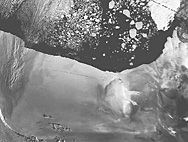Glaciers |
| Glaciers
| Glacier Map |
Different Types of Glaciers | Glacier
Quiz | More Glaciers |
Works Cited |
Glaciers are large masses of snow, recrystallized ice and rock debris that accumulate in great quantities and begin to flow outwards and downwards under the pressure of their own weight. Glaciers form when yearly snowfall in a region far exceeds the amount of snow and ice that melts in a given summer. In this way, massive quantities of material accumulate in relatively small periods of geologic time.
Glaciers are more-or-less permanent bodies of ice and compacted snow that have become deep enough and heavy enough to flow under their own weight. Today, glaciers are found in mountainous regions or in the very cold areas around the poles, and cover only about 10% of the Earth's surface. During past glacial periods this area increased considerably so, although active glaciation is very limited in Europe now, and non-existent in the UK, much of the landscape of northern Europe shows evidence of past glacial activity.
How glaciers form and flow
Glaciers develop where the temperatures are cold enough to allow snow to accumulate over a period of years. Favourable conditions are found around the poles and at high altitudes in lower latitudes, i.e. mountainous regions such Northern Scandanavia and the Alps. Enough snow must fall each winter to ensure that it doesn't all melt in the summer. This way, the amount of snow lying on the ground gets deeper each year as new snow is added to the remains of last years fall.
|
Firn grains are generally four to 16 times the size of the original snow crystal and increase in size as the weight of the overlying snow increases. As the grains grow, they slowly snuff out pockets of existing air between the grains. Over time, individual firn grains are pressed together to form larger crystals, ultimately forming slabs of glacier ice |
||||||||||
|
|
|||||||||

image of Ross Ice Shelf, Antarctica